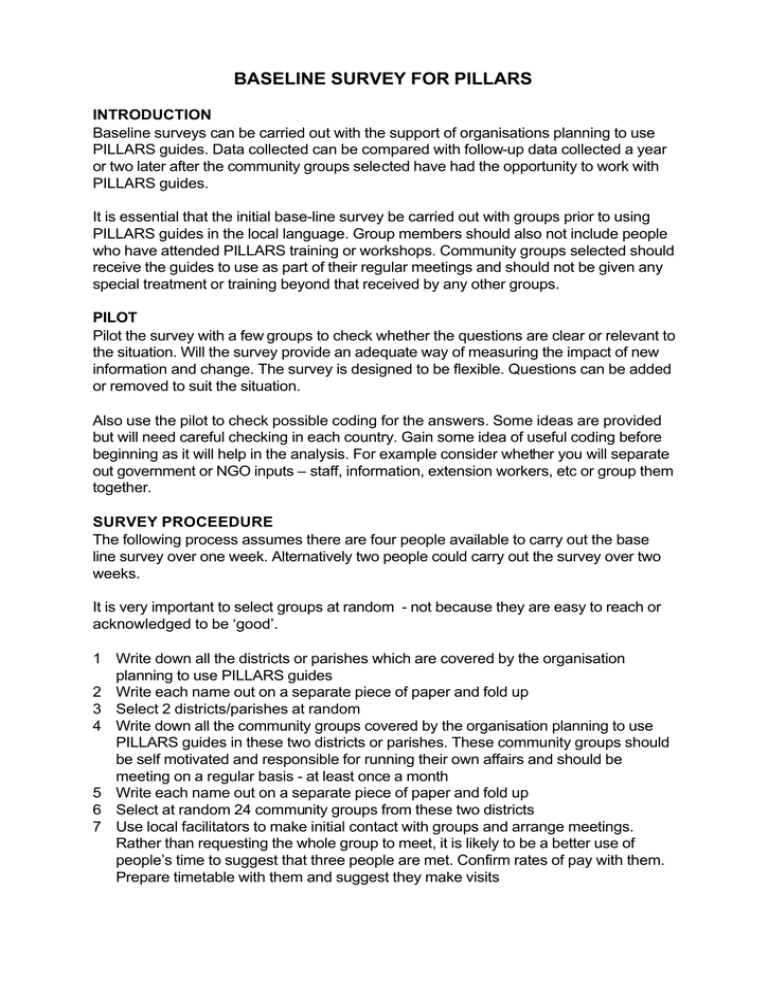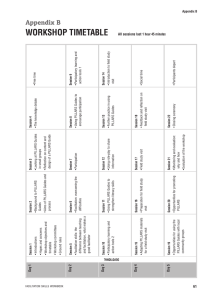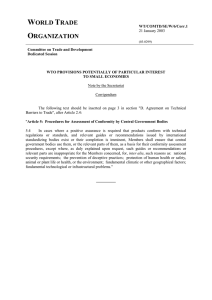BASELINE SURVEY FOR PILLARS
advertisement

BASELINE SURVEY FOR PILLARS INTRODUCTION Baseline surveys can be carried out with the support of organisations planning to use PILLARS guides. Data collected can be compared with follow-up data collected a year or two later after the community groups selected have had the opportunity to work with PILLARS guides. It is essential that the initial base-line survey be carried out with groups prior to using PILLARS guides in the local language. Group members should also not include people who have attended PILLARS training or workshops. Community groups selected should receive the guides to use as part of their regular meetings and should not be given any special treatment or training beyond that received by any other groups. PILOT Pilot the survey with a few groups to check whether the questions are clear or relevant to the situation. Will the survey provide an adequate way of measuring the impact of new information and change. The survey is designed to be flexible. Questions can be added or removed to suit the situation. Also use the pilot to check possible coding for the answers. Some ideas are provided but will need careful checking in each country. Gain some idea of useful coding before beginning as it will help in the analysis. For example consider whether you will separate out government or NGO inputs – staff, information, extension workers, etc or group them together. SURVEY PROCEEDURE The following process assumes there are four people available to carry out the base line survey over one week. Alternatively two people could carry out the survey over two weeks. It is very important to select groups at random - not because they are easy to reach or acknowledged to be ‘good’. 1 Write down all the districts or parishes which are covered by the organisation planning to use PILLARS guides 2 Write each name out on a separate piece of paper and fold up 3 Select 2 districts/parishes at random 4 Write down all the community groups covered by the organisation planning to use PILLARS guides in these two districts or parishes. These community groups should be self motivated and responsible for running their own affairs and should be meeting on a regular basis - at least once a month 5 Write each name out on a separate piece of paper and fold up 6 Select at random 24 community groups from these two districts 7 Use local facilitators to make initial contact with groups and arrange meetings. Rather than requesting the whole group to meet, it is likely to be a better use of people’s time to suggest that three people are met. Confirm rates of pay with them. Prepare timetable with them and suggest they make visits 8 Request permission (letter from Organisation or local facilitator) to visit groups allowing up to 3 hours contact with each group. Assume that two or three groups will be unable to meet at the specified time. 9 Arrange visiting schedule of 2-3 groups per day over one full week for each mini team consisting of two people, usually a staff member plus a local facilitator. 10 Arrange transport and accommodation 11 Both mini teams ideally to meet up each day, to compare notes, write up data and cross check each others findings. 12 A brief report on the process (2-4 pages) should be made by staff giving details of the process followed, procedure followed for the selection of groups, problems arising, relevant observations and conclusions. 13 Completed forms should be photocopied (for safety!) and copies kept. DATA COLLECTION Data collection will comprise a mix of quantitative data established through observation and questions, and qualitative data established through discussion and observation. It is vital to keep the time with group members relaxed and enjoyable. Please don’t arrive with a clipboard and interrogate the members. Instead arrive, make relaxed introductions, explain the purpose for the visit. Explain that we are interested to learn about how their group obtains new ideas, where they get useful information and how they use this in their group. Ask politely about the background to the group and their aims. Allow discussion to develop rather than asking a series of questions. You will often find the answers to certain questions will be provided without needing to ask that question! Some of the questions you can obtain yourself, such as distance from road with public transport and facilities. It is recommended to meet with about three representatives of the group unless the meeting coincides with a regular meeting. Take careful note of the names, age, gender and roles of the respondents, so that these people can be contacted for the return visit to assess impact. Note any additional useful observations. Also try and write down any interesting comments (positive and negative) as quotes. It is very useful for one member of the team to discretely makes notes while the other encourages discussion. This additional information may prove as useful as the answers themselves. Once everyone is relaxed and at ease, then complete some of the more personal enquiries - income, literacy, education levels etc. If the whole group is present this can be done by a show of hands, but also ask for comments around these. When asking for a show of hands to assess literacy levels, education levels, access to radio, newspaper, books etc., please remember this information will be of no use unless you also note the total number of people present. As members may come and go, keep an eye on this, you may need to repeat this several times. I suggest whoever asks the questions, counts the hands in the air, but the other note-taker, quietly counts the total present. If meeting with representatives, ask them to answer on behalf of the group assuming they know the members well enough to do this. If you sense real tensions and personality clashes within the group, be careful with encouraging too much discussion around problems within the community or group. Make sure you do not raise issues which leave the group depressed and bring tensions into the open! The last two questions are designed to finish the meeting on a positive note. If members ask questions, do not make promised that cannot be kept, but whenever possible share or follow up information requested. Review the forms each evening - or while travelling from the meeting. Were all the questions covered? Fill in any gaps. Add additional comments which can reveal very interesting details. Remember that the answers will be used as the basis of a follow-up visit a year later. Read each other’s forms. Make sure they are as clear, legible and helpful as possible! In most situations, groups will find this a useful and interesting process. Community groups should not be offered any financial reward for their participation in this exercise. However copies of Footsteps or other local publications could be given and groups should be assured that they will get two copies of every Xxxxxxxx guide published. However please do not offer any printed or other information until the farewells are being made. Analysis of data Some questions provide clear factual answers. These can be entered, the total worked out and divided by the number of groups to provide the average. However many questions are open and qualitative, making analysis a lot harder. Answers for these questions need to be coded – all similar responses are given a number code so that the results can be analysed. Sample answers are provided. However these are likely to differ for each country. Before doing the baseline survey, it is recommended that you pilot it with a couple of groups and use their answers to help develop appropriate coding. Coding can be left until after the baseline, but some work will help work out similar categories and will make data entry much easier. However be careful not to think that everything can be coded beforehand. Always leave room for new answers and be flexible. There is a balance between sticking rigidly to a few codes and allowing a huge range of answers resulting in about 20 possible categories for answers. This will give fairly meaningless findings. The ideal is to have 4 to 6 codes for each answers. Several questions allow for up to three responses. Record these in separate columns. If people want to give more than three responses, ask them to prioritise or rank them in order of importance. Then use just the top three. Totals for analysing these will be a lot higher. Make sure you divide by the total responses, not by number of groups to get accurate percentages. IMPACT ASSESSMENT The impact of using guides should be assessed after enough time has elapsed for any changes agreed by the group to be implemented. This will depend on when the guides were first used, the frequency with which the group meets and any training received. Usually at least one year, maybe two or three years is recommended. In the interim, keep records about which guides were sent and when. To assess impact it is essential to return to exactly the same communities and ideally to meet with the same people. If three people were met with originally and one has since left, meet with the original two rather than drawing in a new person. If only one or none remains, ask to meet with people who have similar ages, gender and roles in the group, to the original people met. You may like to add it some additional questions that are specific to the guides used. For example ask if particular ideas were tried out and with what result. Ask about how they found the guides. Also try and discover if using the guides through discussion based learning has increased people’s confidence. PILLARS BASELINE SURVEY 1 Date 2 Survey area 3 Names of data collectors 4 Time of Arrival: Time of Departure: 5 Name of Group Ref No Names of representatives (age, gender?) District / Parish 6 Address (full postal address) What kind of Group is this? 7 Location of Group Meeting place – where does the group usually meet? 8 Distance of meeting place from a road with public transport 9 How many years is it since the group started? 10 Why did group form or start? 11 Frequency of meetings Twice weekly Weekly Every two weeks Monthly Occasional 12 What do members do when the group meets? (practical work, discussion, training?) 13 How many members are there in the group? Total Men Women 14 Is membership open to all – or are there limitations or costs which prevent some people joining? 15 Group activities – what is the main purpose of the groups activities? (list up to three) 16 How much income (if any) does the group have each year? How is it raised? How is it used? 17 What are the aims and objectives of the group? (choose up to three) 18 What organisations support the group (with training, information, funding etc) (choose up to three) 19 What strengths does our community have? (List up to three) 20 What particular needs does our community have? (list up to three) 21 What sort of information would be useful to group members? (choose up to three) 22 Information sources – where do members get information from? (list up to three) 23 What problems do members face in obtaining useful information? (list up to three) 24 What are the strengths of the group? (list up to three) 25 What sort of problems does the group face? (list up to three) 26 Literacy levels in English Total present Men Women Literacy levels in xxxxxxx Total present Men Women Total present Men Women 27 Education Levels 28 Access to Radio or TV Total present 29 Access to books and newsletters Total present 30 Access to email and web Total present 31 Access to CD ROMS Total present 32 Benefits of group membership (list up to three) 33 Achievements of group (list up to three) 34 Additional notes and information about the group and their situation


